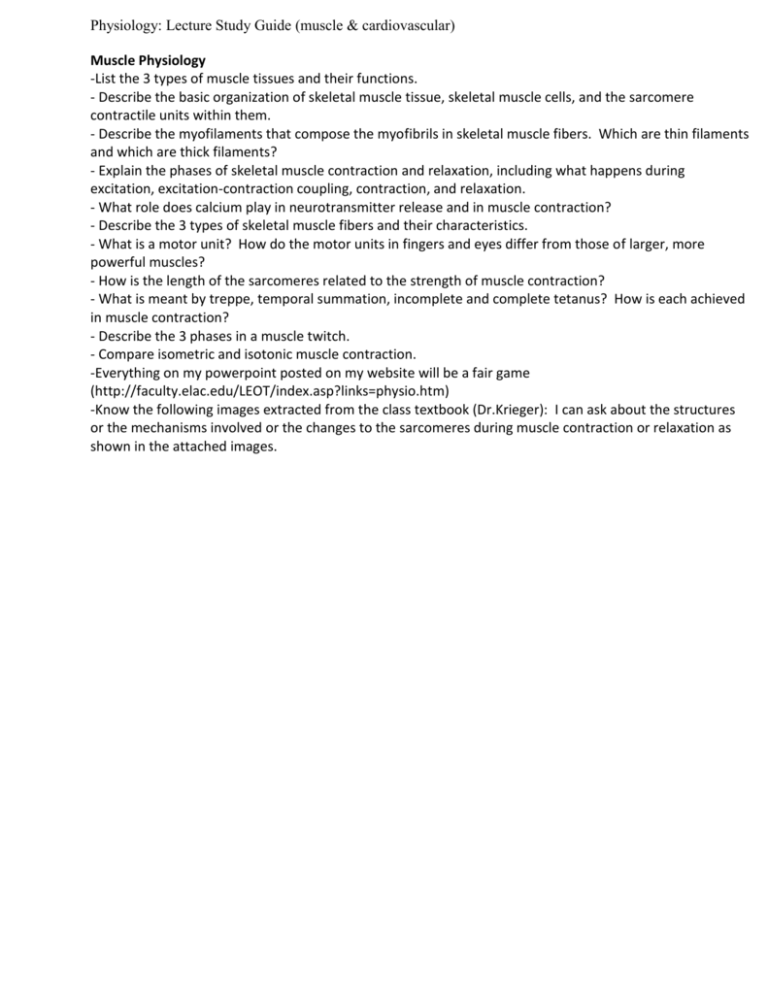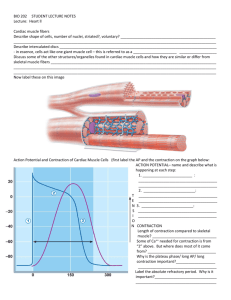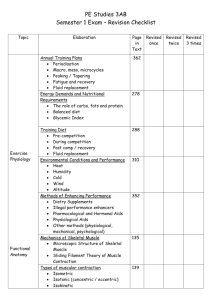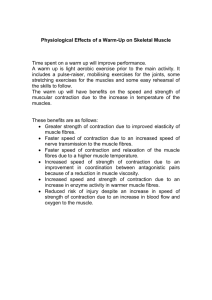Physiology: Lecture Study Guide (muscle & cardiovascular) Muscle
advertisement

Physiology: Lecture Study Guide (muscle & cardiovascular) Muscle Physiology -List the 3 types of muscle tissues and their functions. - Describe the basic organization of skeletal muscle tissue, skeletal muscle cells, and the sarcomere contractile units within them. - Describe the myofilaments that compose the myofibrils in skeletal muscle fibers. Which are thin filaments and which are thick filaments? - Explain the phases of skeletal muscle contraction and relaxation, including what happens during excitation, excitation-contraction coupling, contraction, and relaxation. - What role does calcium play in neurotransmitter release and in muscle contraction? - Describe the 3 types of skeletal muscle fibers and their characteristics. - What is a motor unit? How do the motor units in fingers and eyes differ from those of larger, more powerful muscles? - How is the length of the sarcomeres related to the strength of muscle contraction? - What is meant by treppe, temporal summation, incomplete and complete tetanus? How is each achieved in muscle contraction? - Describe the 3 phases in a muscle twitch. - Compare isometric and isotonic muscle contraction. -Everything on my powerpoint posted on my website will be a fair game (http://faculty.elac.edu/LEOT/index.asp?links=physio.htm) -Know the following images extracted from the class textbook (Dr.Krieger): I can ask about the structures or the mechanisms involved or the changes to the sarcomeres during muscle contraction or relaxation as shown in the attached images. Cardiovascular Physiology 1. Describe the general route of blood flow through the heart and body. 2. What is the right side of the heart responsible for? What does the left side of the heart do? 3. What are intercalated discs in cardiac muscle tissue? How do they aid cardiac muscle contraction? 4. Describe the roles of the autorhythmic and contractile cells. I. Describe how each is depolarized and repolarized. All of the steps are listed on the ppt -- they will definitely be a "FAIR GAME" for the exam. 5. Describe the roles of the sympathetic and parasympathetic nervous systems in modulating cardiac contractile force and heart rate. 6. Describe the sequence of the conduction system through the heart. What nodal tissues are involved? Which nodal tissue sets the normal heart rate? How is heart rate affected if the pacemaker is damaged? 7. What is represented by the P-wave, QRS-complex, and T wave on an electrocardiogram? 8. What causes the “lub-dup” heart sounds? 9. Explain the cardiac cycle, including the events of ventricular filling, ventricular systole, and isovolumetric relaxation (ventricular diastole). What are the EDV and ESV? Be able to trace the Wigger’s diagram as provided in the powerpoint (I also include the diagram at the end of this review guide) 10. What two factors determine cardiac output? (CO = SV x HR) I. Be able to calculate cardiac output when given these two factors, or to calculate either factor when given a cardiac output and one factor. 11. What region of the brain regulates heart rate? 12. Describe the three factors that affect heart stroke volume. I. Contractility. II. Afterload. i. How does the resistance in blood vessels affect the afterload and also, how does the heart compensate if there are changes in the afterload? III. Preload. i. What is Starling’s law of the heart? ii. how do the following factors (venous return or heart filling time) affect the preload? Blood Flow & Blood Pressure 13. Differentiate the changes in the vessel diameter, blood pressure, and velocity of blood flow in the 3 types of blood vessels (arteries, capillaries, and veins). Refer to the diagram from the ppt. I. How and why does blood pressure differ in arteries, arterioles, capillaries, venules, and veins? II. If blood pressure is low in veins and venules, how is blood returned to the heart from the extremities? 14. Blood pressure measurement: what do the systolic and diastolic pressures represent? I. what do these pressures represent? 15. What factors influence blood flow and pressure? Which factor has the greatest effect on blood flow? I. MAP = CO x TPR (resistance) or MAP = 1/3(Psystolic) + 2/3(Pdiastolic) i. resistance = 8nl/πr4 (n = viscosity, l= length, r=radius) ii. What is MAP (mean arterial pressure)? How is it calculated? Why isn’t it the average of the systolic and diastolic pressures? II. How does atherosclerosis affect the blood flow? How does it affect the MAP? NOTE: all points, including the equations, stated in the powerpoint and any additional remarks added during lecture will be a "FAIR GAME" for the exam!!!







